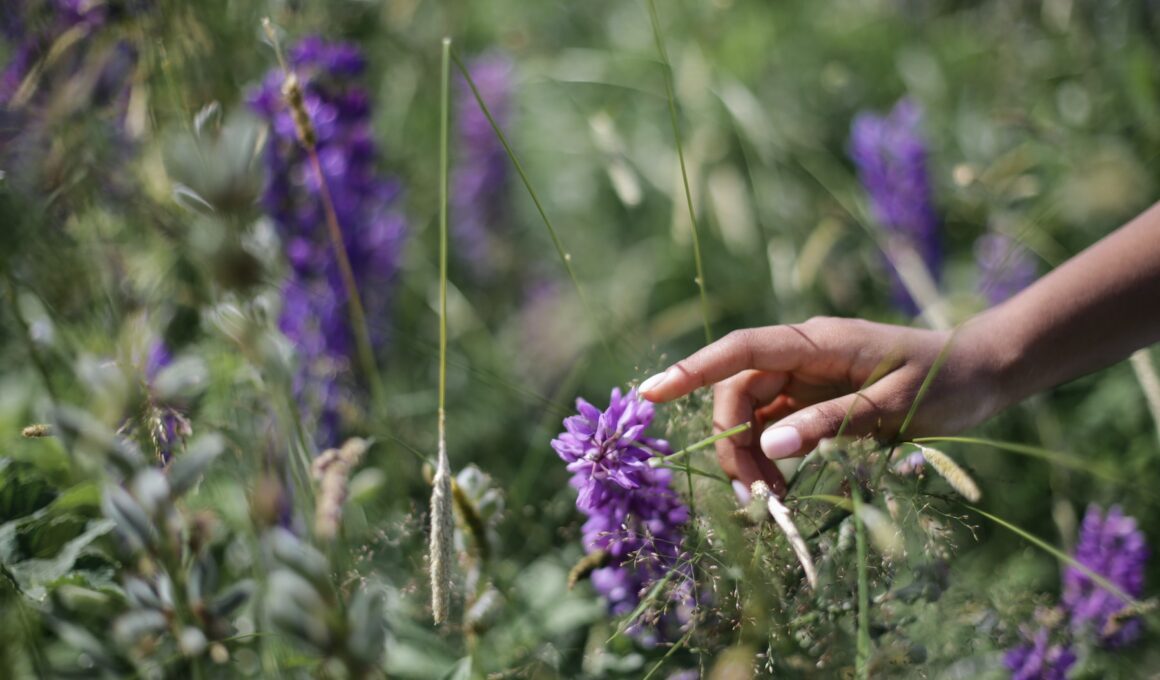Are you curious about whether lupins are perennial plants? You’re not alone! Many gardeners wonder if these beautiful flowers will come back year after year or if they are annuals that need to be replanted each season.
The answer is that it depends on the type of lupin you have. In this article, we’ll explore the different types of lupins and identify which ones are perennial. We’ll also share some tips on caring for these plants and growing them from seed, so you can enjoy their stunning blooms for years to come.
As a gardener, you want to invest your time and effort into plants that will thrive and provide beauty in your outdoor space. Understanding whether lupins are perennial or not is an important factor in deciding if they are the right choice for your garden.
By learning about the different types of lupins and how to care for them properly, you can ensure that they will continue to bring joy and color to your yard for seasons to come. So, let’s dive in and discover all there is to know about these gorgeous flowers!
Understanding the Different Types of Lupins
This section helps you understand the various types of lupins available, so you can choose the best one for your garden. Lupin varieties come in different colors, such as pink, purple, yellow, and white. Some of the most common types of lupins are the Russell hybrid lupins, dwarf lupins, and tree lupins. Understanding the different types of lupins is essential in determining which one will thrive in your garden.
When it comes to growing conditions, lupins prefer a sunny spot in well-draining soil. They can tolerate some shade, but the flowers may not be as vibrant. Lupins don’t like wet soil, so make sure the soil is not waterlogged. If you live in a region with hot summers, your lupins will appreciate some afternoon shade.
Incorporating different varieties of lupins in your garden can add a pop of color and texture. By learning about the growing conditions and characteristics of each type, you can create a beautiful and thriving lupin garden. Remember to provide adequate sunlight and well-draining soil to ensure your lupins grow healthy and strong.
Identifying Perennial Lupins
Finding perennial lupins is all about identifying the right characteristics. Perennial lupin varieties, unlike annuals, are designed to grow back year after year. They have a long taproot that helps them survive harsh winters and droughts. These lupins also have a thicker stem and larger leaves compared to their annual counterparts.
To identify perennial lupins, look for their foliage. Perennial lupins have larger leaves that grow in a more spaced-out pattern on the stem. These leaves are also thicker and more durable than those of annual lupins. Additionally, perennial lupins produce a larger and more vibrant flower head, which is a sign that the plant is healthy and well-maintained.
Lupin maintenance is key to ensuring that your plants come back year after year. Regular pruning and deadheading will help promote new growth and keep the plant healthy. It’s also important to make sure your lupins are receiving enough water and nutrients, especially during the growing season.
With proper care, perennial lupins can provide a beautiful addition to any garden for years to come.
Is Lupin the Most Popular Perennial Plant?
Lupin is undoubtedly the most popular perennial plant amongst garden enthusiasts. Its vibrant flowers and ability to thrive in various climates make it a beloved choice. Lupins are known for their striking appearance and can add a bold splash of color to any garden. These fantastic plants have definitely earned their status as the most popular perennial.
Caring for Perennial Lupins
If you want to keep these beautiful flowers blooming year after year, taking regular care of them is key. This includes pruning, deadheading, and providing adequate water and nutrients during the growing season.
Pruning techniques for perennial lupins include removing dead or damaged stems, cutting back the plant by one-third every two to three years, and pinching off the dead flowers to promote more blooms. You can also trim the plant in the early spring to encourage new growth.
Soil preparation is also important for caring for perennial lupins. Before planting, make sure the soil is well-drained and has a pH level between 6.0 and 7.0. Adding organic matter such as compost or well-rotted manure can improve soil structure and fertility. Mulching around the base of the plant can help retain moisture and suppress weed growth.
By following these simple care techniques, you can ensure that your perennial lupins will continue to bloom year after year. With proper pruning and soil preparation, these beautiful flowers will thrive in your garden and provide a colorful addition to your landscape.
Growing Lupins from Seed
Growing these beautiful flowers from seed can be a rewarding experience that allows you to cultivate a personal connection with your garden. Lupins are hardy plants that can grow in a variety of soil types and climates. With proper care and attention, you can enjoy their vibrant colors and sweet fragrance for years to come.
Here are some tips for successfully growing lupins from seed:
-
Seed germination: Lupin seeds need to be scarified (scratched or nicked) before planting to help them absorb water and germinate. Soak the seeds in water overnight, then gently rub them with a piece of sandpaper or a nail file. Plant the seeds about 1 cm deep and keep the soil moist but not waterlogged.
-
Transplanting techniques: When the seedlings have 4-6 leaves, they are ready to be transplanted into larger pots or directly into the garden. Lupins have long taproots that can be easily damaged, so be sure to use a deep pot or dig a deep hole in the garden. Water the seedlings well before and after transplanting, and keep the soil moist until they become established.
With a little patience and care, you can enjoy a beautiful lupin garden that you’ve grown from seed. Remember to give your plants plenty of sunlight, well-drained soil, and regular watering. Happy planting!
Conclusion and Final Thoughts
It’s time to sit back, relax, and watch your hard work pay off as your garden blooms with the vibrant colors and sweet fragrance of these beautiful flowers. Planting perennial lupins can be a great addition to any garden.
Not only do they add a pop of color, but they also attract pollinators like bees and butterflies. Plus, they require very little maintenance once established, making them a perfect choice for those who want a low-maintenance garden.
If you’re thinking about planting lupins, the best time to do so is in the fall or early spring. This gives them time to establish their roots before the heat of summer sets in. Once established, they can survive for many years, providing a beautiful display of color year after year.
And because they are perennials, you won’t have to worry about replanting them every year like you would with annuals. Incorporating lupins into your garden not only adds visual interest but also provides many benefits.
From attracting pollinators to requiring little maintenance, planting perennial lupins is a great choice for any gardener. So, go ahead and add some color and beauty to your garden with these stunning flowers.
Frequently Asked Questions
What is the history of lupins and their use in different cultures?
Lupins have a rich cultural significance and have been used in culinary traditions throughout history. In some cultures, they’re believed to bring good luck and prosperity.
Lupin beans have been used as a substitute for meat in many vegetarian dishes, and the plant itself has been used in traditional medicine to treat a variety of ailments.
Lupins have also been used as a natural fertilizer and to prevent soil erosion. Their versatility and usefulness have made them an important crop in many parts of the world.
Whether you’re cooking up a delicious lupin-based dish or simply appreciating their cultural significance, these plants are sure to add a unique and flavorful touch to your life.
How do lupins affect the environment and wildlife in their native regions?
Did you know that lupins can have a significant ecological impact on their native regions?
As their popularity grows, so does their potential to disrupt natural habitats and displace native species.
However, with careful management and habitat preservation efforts, it’s possible to minimize these negative effects and promote a healthy balance between lupins and the surrounding environment.
By being mindful of the potential consequences and taking proactive steps to mitigate them, we can ensure that lupins continue to be a beautiful and beneficial addition to our natural landscapes.
Are there any health benefits or medicinal uses for lupins?
Did you know that lupins have potential health benefits? Lupin protein is a great source of amino acids and can help with muscle growth and recovery. Lupin oil is high in healthy fats and can lower cholesterol levels.
However, it’s important to note that some people have a lupin allergy, which can cause symptoms such as hives, difficulty breathing, and anaphylaxis. Additionally, lupin seeds contain alkaloids that can be toxic in large quantities.
As with any food or supplement, it’s important to consult with a healthcare professional before incorporating lupins into your diet.
Can lupins be used in cooking or as an ingredient in food products?
Looking for a new ingredient to spice up your cooking? Look no further than lupins! They’re not only delicious but also pack a nutritional punch.
Lupin recipes can range from savory to sweet and can be used in dishes like soups, salads, and even baked goods. In fact, lupins can be ground into a flour that can be used as a substitute for wheat flour in gluten-free recipes.
But the benefits don’t stop there – lupins are also high in protein, fiber, and essential vitamins and minerals. So, next time you’re looking for a healthy and tasty addition to your meals, consider giving lupins a try.
What are some common pests and diseases that affect lupins, and how can they be prevented or treated?
To keep your lupins healthy and disease-free, it’s important to practice integrated pest and disease management. This involves using natural predators and companion planting to deter pests and diseases.
Some common pests that affect lupins include aphids, spider mites, and slugs. These can be controlled with natural predators such as ladybugs and lacewings, or by using companion plants like marigolds or garlic.
Diseases such as powdery mildew and root rot can also be prevented or treated with proper soil drainage and fungicidal sprays.
By using these techniques, you can ensure that your lupins thrive and remain a beautiful addition to your garden.
Conclusion
So, now you know that lupins can be both annual and perennial, and you’ve learned how to identify and care for the perennial varieties.
With a little bit of effort and attention, you can enjoy beautiful lupins in your garden year after year. Remember to choose a sunny spot, keep the soil moist, and deadhead regularly to promote new growth and prevent self-seeding.
If you’re growing lupins from seed, be patient and give them time to establish themselves. With these tips in mind, you’re well on your way to growing a successful lupin garden.








